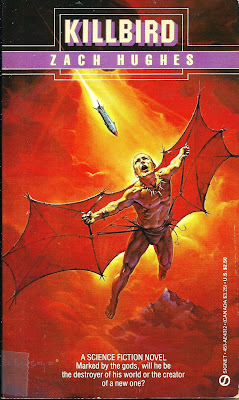Book Review: 'Killbird' by Zach Hughes
'Killbird' (170 pp) was published by Signet in June, 1980. The cover illustration is by Ken Kelly.
'Zack Hughes' was the pen name of the U.S. author Hugh Derrel Zachary (1928 - 2016). In addition to science fiction, Hughes / Zachary also wrote softcore porn (A Dick for All Seasons, 1970) and horror (The Revenant, 1988) novels.
'Killbird' belongs to the sub-genre of sci-fi novels in which the representative of a post-apocalyptic world gradually comes to an understanding of the circumstances by which the Ancients (or the Forerunners, or the Gods, or the Exalted Ones, etc., etc.) have left behind various artifacts in the landscape. These artifacts offer both danger and opportunity to those brave enough (or foolhardy enough) to violate the taboos and warnings of the Seers and Wise Women.
In this case, a tribesman named Eban contests for the favors of the comely Yuree, the headman's daughter. In so doing, his actions make him an outcast. In his subsequent wanderings of the wilderness he encounters regions of 'evil' (i.e., radiation), 'dragons' (i.e., ancient war machines) and the abodes of the Giants (i.e., the high-tech constructs of the since-departed Ancestors).
During the course of these explorations Eban comes to greater awareness of the ambiguous nature of the Gods (particularly their aerial weapons, the Killbirds of the book's title) and what this portends for the fate of himself and his people. The book's closing chapters provide an explanation of the nature of Eban's world, as well as some tie-ins to the wider universe defined in Hughes's previous novel The Legend of Miaree (1974).
Although 'Killbird' doesn't bring anything particularly imaginative to the post-apocalyptic genre, within its relatively short length it is smoothly written, well-paced, and avoids contrived revelations in its denouement. In this regard, it's a solid three-star title.
















































.jpg)

















